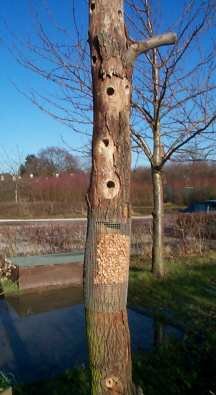Birds That Have Visited The Feeders
Hawfinch
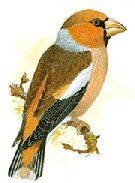
Possibly the rarest bird to have visited the feeding station (17/02/04). The Hawfinch is the UK's largest finch, it has a massive, powerful bill. Always shy and difficult to see, the hawfinch has become even more enigmatic in recent years with a decline in many of its traditional breeding areas. Numbers are hard to determine, however, as hawfinches are easily overlooked, especially in summer.
In the winter the Hawfinch remains in mixed or broadleaved woodland but also feeds in suitable areas nearby, such as tall hedgerows with scattered trees, mature avenues of limes, beeches and other trees and even some large gardens; hornbeam is a favourite tree.
Hawfinches are now mostly restricted to England in the UK, and have declined in many areas. Parts of western England near the Welsh Borders, the Home Counties and the south-east from Hampshire to Kent remain the most likely places to find them. They can occasionally be seen at RSPB nature reserves such as Nagshead, Gloucestershire and Blean Woods, Kent. Hawfinches may perch high in trees, but also feed on the ground and much more inconspicuously among the foliage. The Hawfinch eats Seeds, buds and shoots and has a sharp, thin ticking call; song thin and wheezy call.
Brambling

Similar in size and shape to the chaffinch, the male has a black head in summer, and an orange breast with white belly. In flight it shows a long white rump. Gregarious in winter, it may form flocks of many thousands and often joins with chaffinches. Numbers can vary between winters depending on food supplies. In winter the Brambling likes beech woodland and farmland fields near woods. Watch out for them from mid-September until March and April. Occasional birds stay into May or even later.
Jay

Jays are famous for their peanut and acorn feeding habits and during September and October can often be seen burying peanuts and acorns for retrieving later in the winter.
Blackbird
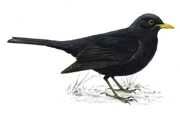
Blackbirds are birds of woodland and heaths which have readily adapted to farmland and gardens. They like areas with bushes, shrubs and trees, and nearby open ground and short grass.
Blue Tit
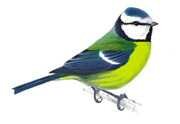
Almost any garden with a peanut feeder will attract them and they readily breed in nestboxes. In winter they form flocks with other tit species and a garden with four or five at a bird table at any one time, may be feeding 20 or more.
Great Tit
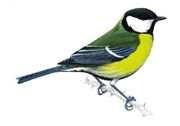
The largest UK tit - green and yellow with a striking glossy black head with white cheeks and a distinctive two-syllable song. It is a woodland bird which has readily adapted to man-made habitats to become a familiar garden visitor. It can be quite aggressive at a bitdtable, fighting off smaller tits. In winter it joins with blue tits and others to form roaming flocks which scour gardens and countryside for food.
Greenfinch
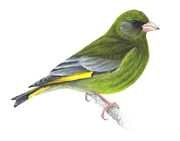
Its twittering and wheezing song, and flash of yellow and green as it flies, make this finch a truly colourful character. Nesting in a garden conifer, or feasting on black sunflower seeds, it is a popular garden visitor, able to take advantage of food in town and city gardens at a time when intensive agriculture has deprived it of many weed seeds in the countryside. Although quite sociable, they may squabble among themselves or with other birds at the bird table.
Robin
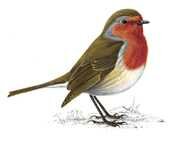
The Robin is possibly The UK's favourite bird - with its bright red breast it is familar throughout the year and especially at Christmas! Males and females look identical, and young birds have no red breast and are spotted with golden brown. Robins sing nearly all year round and despite their cute appearance, they are aggressively territorial and are quick to drive away intruders. They will sing at night next to street lights.
Great Spotted Woodpecker
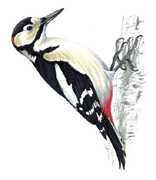
The Great Spotted Woodpecker can be seen in most parks and large gardens and will come to peanut feeders and birdtables.
Sparrowhawk
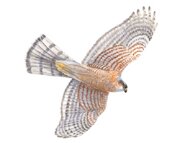
It is a fact of life (or nature!) that wherever you have a bird feeding station you will sooner or later attract the attentions of a sparrowhawk. The male sparrowhawk is one of the smallest British raptors, with short rounded upperparts and is white below, closely barred with orange. females are larger with brown upperparts and dark-barred underparts. Their broad, rounded wings and long tail are adapted for flying between trunks and branches enabling them to weave in and out of trees at high speed. They never hover like kestrels. They prefer conifer woodlands for nesting but are also found in broad-leaved woodland and even thick hedges. Most recently they have spread into urban parks and cemeteries and are now regular garden visitors. They tend to have traditional territories and will usually build new nests each year. The sparrowhawk is usually seen flying fast and low in pursuit of prey, or soaring high on rounded wings.
Chaffinch
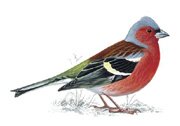
The chaffinch is the UKs second commonest breeding bird, and is arguably the most colourful of the UK's finches. Its patterned plumage helps it to blend in when feeding on the ground and it becomes most obvious when it flies, revealing a flash of white on the wings and white outer tail feathers. It does not feed openly on bird feeders - it prefers to hop about under the bird table or under the hedge. Youll usually hear chaffinches before you see them, with their loud song and varied calls.
Dunnock

Also known as the Hedge sparrow and the Hedge accentor.
A small brown and grey bird. Quiet and inobtrusive, it is often seen on its own, creeping along the edge of a flower bed or near to a bush, moving with a rather nervous, shuffling gait, often flicking its wings as it goes. When two rival males come together they become animated with lots of wing-flicking and loud calling. The dunnock needs areas with thick vegetation - thickets, brambles, hedges, woodland edges. It will readily use man-made habitats like parks, gardens and churchyards and eats Insects, spiders, worms and seeds.
Goldfinch
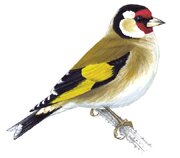
A highly coloured finch with a bright red face and yellow wing patch. Sociable, often breeding in loose colonies, they have a delightful liquid twittering song and call. Their long fine beaks allow them to extract otherwise inaccessible seeds from thistles and teasels. Increasingly they are visiting birdtables and feeders. In winter many UK goldfinches migrate as far south as Spain. The Goldfinch likes trees and bushes with areas of tall weeds nearby. It often breeds near man in parks, gardens, nurseries, orchards and churchyards. In wider countryside it likes woodland edges and heaths and commons with gorse and hawthorn. In winter Goldfinches form into flocks which may range over waste land, coastal fields and flats, and rough pasture. Anywhere with plenty of thistles, burdock and teasels.
Woodpigeon
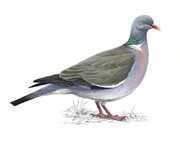
The UK's largest and commonest pigeon, it is largely grey with a white neck patch and which wing patches, clearly visible in flight. Although shy in the countryside it can be tame and approachable in towns and cities. Its cooing call is a familiar sound in woodlands as is the loud clatter of its wings when it flies away. The Woodpigeon eats crops like cabbages, sprouts, peas and grain. Also buds, shoots, seeds, nuts and berries.
House Sparrow
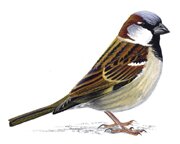
Noisy and gregarious, these cheerful exploiters of man's rubbish and wastefulness, have even managed to colonise most of the world. The ultimate opportunist perhaps, but now struggling to survive in the UK along with many other once common birds. They are clearly declining in both gardens and the wider countryside and their recent declines have earned them a place on the Red List. In winter it can be found in large flocks in farmland fields. They gather in trees and hedgerows and often roost communally in ivy-covered walls.
Green Woodpecker
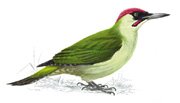
The Green Woodpecker is the largest of the three woodpeckers that breed in Britain. It has a heavy-looking body, short tail and a strong, long bill. It is greeny-grey on its upperparts with a bright green rump and red on the top of its head. They have an undulating flight. They climb up tree trunks and branches and will move around to be on the side away from anyone watching. The Green Woodpecker is found mainly in broad-leaved (deciduous) woodland where it nests in mature trees in the bottom of a specially dug out hole on the trunk or a main branch. Individuals seldom move far from their original nest site, although young birds may disperse in autumn and winter to feeding areas away from woods and trees.
Little Egret
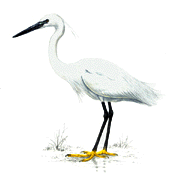
Surely the most surprising visitor to the feeding station and, perhaps, an indication of just how common these delightful birds are becoming in Southend. Steve Bunn of the Essex Rangers reported today (12/01/04) that a Little Egret had visited the Chapel Lane car park and had spent some time on the ground around the feeding area.
Other Visitors
Black-headed Gull 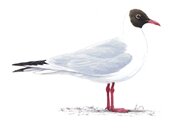 |
Collared Dove 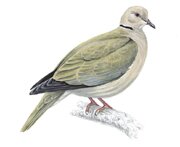 |
Carrion Crow 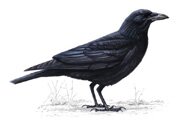 |
Mistle Thrush
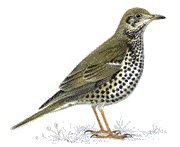 |
Song Thrush
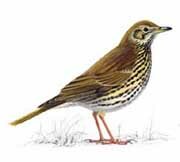 |
|
|
























